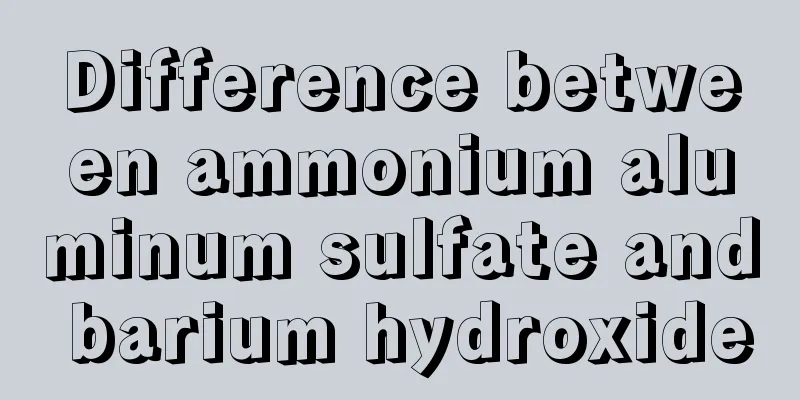Difference between ammonium aluminum sulfate and barium hydroxide

|
Ammonium aluminum sulfate is a transparent crystal or white powder, and can be dissolved in water. Ammonium aluminum sulfate tastes slightly sweet, but its melting point is very high, reaching about ninety-three degrees. Barium hydroxide is highly corrosive and is widely used in the rubber industry. Its melting point can reach more than 300 degrees. It also has good alkalinity. So what are the differences between ammonium aluminum sulfate and barium hydroxide? First, what are the differences between ammonium aluminum sulfate and barium hydroxide? The taste is slightly sweet and astringent. It loses 10 molecules of crystal water at 120°C, becomes anhydrous at about 250°C, and decomposes above 280°C. 1g is dissolved in 7ml water and 0.5ml boiling water. It is easily soluble in glycerol, almost insoluble in ethanol, and its aqueous solution is acidic to litmus. The pH of 0.05mol/L solution is 4.6. Relative density: 1.64. Refractive index: 1.459. Barium hydroxide is colorless transparent crystals or white powder. It can lose 7 molecules of crystal water in a sulfuric acid dryer and lose all the crystal water at about 78°C. Soluble in water and methanol, slightly soluble in ethanol, and almost insoluble in acetone. If it quickly absorbs carbon dioxide from the air and turns into carbonate, it cannot be completely dissolved in water. Relative density: 2.188. Melting point: 78°C (octahydrate, in the case of pure barium hydroxide, the temperature is >408°C). Refractive index: 1.471. Highly toxic. Highly corrosive. Used to measure carbon dioxide in the air. Quantification of chlorophyll. Refining of sugar and animal and vegetable oils. Boiler water cleaner. Insecticide. Rubber industry. Second, ammonium aluminum sulfate is white shiny crystals, granules or powder. Sweet taste. Stable in air. It loses part of its crystalline water at 86.5℃ and loses all of its crystalline water at 250℃. When heated it expands violently and becomes a spongy substance. When burned to red heat, it decomposes into sulfur trioxide and aluminum oxide. Weathering occurs when the relative humidity is about 25% below zero. It is easily soluble in water, almost insoluble in ethanol, and the solution is acidic. After long boiling, insoluble alkaline salts precipitate. Relative density: 1.62. Aluminum sulfate is a widely used industrial reagent that is often confused with alum (potassium aluminum sulfate dodecahydrate). What are the differences between ammonium aluminum sulfate and barium hydroxide? Precautions for the operation of ammonium aluminum sulfate: closed operation and local exhaust ventilation. Operators must undergo special training and strictly abide by operating procedures. It is recommended that operators wear self-priming filter dust masks, chemical safety glasses, anti-toxic penetration work clothes, and rubber gloves. Avoid generating dust. Avoid contact with oxidizing agents. Be careful when loading and unloading to prevent damage to the packaging. Equipped with leakage emergency treatment equipment. Empty containers may contain hazardous residues. Storage precautions: Store in a cool, ventilated warehouse. Keep away from fire and heat sources. It should be stored separately from oxidants and should not be mixed. The storage area should be equipped with suitable materials to contain leaks. Barium hydroxide is used as a catalyst for the synthesis of phenolic resin. The polycondensation reaction is easy to control, the resulting resin has low viscosity, fast curing speed, and the catalyst is easy to remove. The reference dosage is 1% to 1.5% of phenol. It is also used as a catalyst for water-soluble urea-modified phenol-formaldehyde adhesives. The cured product is light yellow, and the divalent barium salt remaining in the resin does not affect the dielectric properties and chemical stability. It is used as an analytical reagent, and is also used to separate and precipitate sulfate, make barium salts, and determine carbon dioxide in the air. Quantification of chlorophyll. Refining of sugar and animal and vegetable oils. Boiler water cleaner. Insecticide. Rubber industry. |
<<: Is sulfurous acid a strong acid or a weak acid?
>>: What are the applications of potassium persulfate tablets in aquaculture
Recommend
What is better to add to foot soak?
Although many people know the benefits of foot so...
The best time to treat rectal cancer
The best time for rectal cancer resection: 1. The...
Briefly describe the four major symptoms of gastric cancer
Gastric cancer is the most common malignant tumor...
Can I steam my face if I have allergies? Sensitive skin care
Sensitive skin can cause facial allergies and dis...
The difference between colitis and enteritis, the symptoms of the two should be distinguished
Colitis and enteritis are both common diseases. W...
What should I do if I have dry intestines and constipation
Dry bowel constipation is a common problem, so if...
Pay attention to constipation, it may be an early symptom of colon cancer
If you have colon cancer, you must be in pain. Co...
How to wash bubble gum
Nowadays, many friends are accustomed to eating a...
The difference between rhinitis and nasopharyngeal carcinoma
Nasopharyngeal carcinoma is one of the most commo...
What causes pinworm disease
In our lives, there are many parasites that depen...
When I urinate, I feel stinging pain in my urethra almost after I finish urinating
From a health perspective, a person's excreti...
Traditional Chinese medicine treatment for colon cancer
Traditional Chinese medicine can be used as an ad...
Is iron oxide harmful to human body in life?
Iron oxide is a relatively low-grade dye. It is c...
How to prevent liver cancer? Eating more of these foods can prevent liver cancer
Primary liver cancer is one of the most common ma...
How to remove oil stains from clothes
Accidentally dropping oil stains on clothes is th...









